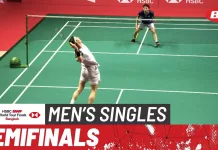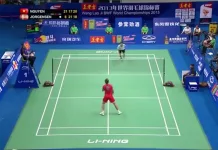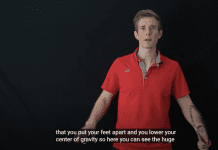
Airbadminton is a variation of badminton that is designed to increase accessibility to the sport by improving outdoor play. The court dimensions, rules, and shuttle are different from the classic game of badminton you are probably familiar with.
The BWf has been pushing this variation of the game for the past 4 years with various community and participation projects. So what is it, is it any good and how do you play?
Airbadminton Court
The Airbadminton court is different from ‘classic’ badminton. The court is 16 metres long and 5 metres wide for 1 on 1 games while a 16×6 court is used for team play. The court is separated in the middle by a net 1.5m high, 8 metres from each back line, as shown on the diagram by the dotted line.
On each side of the net, there is a dead zone. This is essentially the forecourt on a classic badminton court. It is 2 metres from the net on each side of the court.
The air badminton court is surrounded by a ‘free zone’ that is between 2 and 4 metres from the sideline and back line. This ‘free zone’ is simply for safety to give extra room for players to move and limit interference with the court.

There are service markers 3 metres behind the dead zone, labeled on the diagram. This is to demonstrate the position of the server in the game. In this version of the game, there are no tram lines, rear tram, or service boxes, providing a much simpler court for beginner players.
For the best performance, the courts should be set up laterally to the prevailing wind direction to allow for better shuttle
performance. Courts should also be set up north-south to avoid direct sunlight affecting players’ vision.
Airbadminton Rules
Firstly the similarities. As in ‘classic’ badminton you score points by hitting the shuttle over the net between two opposing players until one side can no longer return the shuttle either due to the shuttle landing in their court, the shuttle lands out of bounds, the shuttle hits the net, the shuttle is hit but doesn’t go over the net or the shuttle hits the player’s body.
One of the first differences is the serve. As mentioned in the previous court features, there is a service marker 3 metres behind the dead zone. The server must stand behind this line when serving and hit the shuttle into the opponent’s red zone on the above diagram. When serving the shuttle needs to be below the height of the net and immediately travel in an upwards direction when the shuttle is hit.
The scoring system is the same as traditional badminton, the person that wins the rally gains a point. It is suggested by the BWF that games are played by the best of 5 games to 11 points with a setting at 10-10 to 13 points.
The AirShuttle
We have all experienced trying to play outside on the beach or at the park. Using a plastic shuttle and having it blow all over the place making the game unpredictable and very challenging. Due to this, the BWF has designed a new type of shuttle specifically for Airbadminton called the Airshuttle.
This shuttle is designed to fly as similar to a traditional shuttle as possible as well as sound and feel like one. The BWF made over 30 prototypes before deciding on the Airshuttle which is now produced by numerous manufacturers.
The net system is the same as traditional badminton, the netting is thicker to reduce wind disruption. While the badminton rackets are the same as traditional badminton it is recommended that you play with a lower string tension due to the weight of the Airshuttle.

Airbadminton Competitions
Airbadminton can be played just as traditional badminton is played with singles and doubles. However, a 3v3 and 4v4 format has also been made for Airbadminton with some different rules.
Where singles and doubles are open play, any player can hit the shot at any point, in 3v3 and 4v4 this is different. The team formats stipulate that the same player cannot make consecutive shots, so once a player takes a shot the other players must play the next shot for their team. The BWF says this improves the fun of the game while increasing skill development and demonstration.
One of the formats pushed by BWF is the team relay. Every tie consists of 5 matches, men’s doubles, women’s doubles, mixed doubles, and two triples. One triple is two males one female and the other two females one male player. All of the competitions so far are on sand with a number of events showcasing the sport being held over the last 2 years.

This is the first installment of our Airbadminton series as we look at the impact, merit, and result of Airbadminton.
- Paris Olympics badminton: meet the future stars - July 21, 2024
- How are shuttlecocks made? - July 17, 2024
- Paris Olympics Badminton Draw is here! - July 12, 2024


























